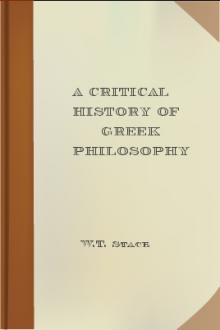A History of Indian Philosophy, Vol. 1 by Surendranath Dasgupta (desktop ebook reader txt) 📕

- Author: Surendranath Dasgupta
- Performer: -
Book online «A History of Indian Philosophy, Vol. 1 by Surendranath Dasgupta (desktop ebook reader txt) 📕». Author Surendranath Dasgupta
There were thus at least three currents of thought: firstly the sacrificial Karma by the force of the magical rites of which any person could attain anything he desired; secondly the Upani@sad teaching that the Brahman, the self, is the ultimate reality and being, and all else but name and form which pass away but do not abide. That which permanently abides without change is the real and true, and this is self. Thirdly the nihilistic conceptions that there is no law, no abiding reality, that everything comes into being by a fortuitous concourse of circumstances or by some unknown fate. In each of these schools, philosophy had probably come to a deadlock. There were the Yoga practices prevalent in the country and these were accepted partly on the strength of traditional custom among certain sections, and partly by virtue of the great spiritual, intellectual and physical power which they gave to those who performed them. But these had no rational basis behind them on which they could lean for support. These were probably then just tending towards being affiliated to the nebulous Sâ@mkhya doctrines which had grown up among certain sections. It was at this juncture that we find Buddha erecting a new superstructure of thought on altogether original lines which thenceforth opened up a new avenue of philosophy for all posterity to come. If the Being of the Upani@sads, the superlatively motionless, was the only real, how could it offer scope for further new speculations, as it had already discarded all other matters of interest? If everything was due to a reasonless fortuitous concourse of circumstances, reason could not proceed further in the direction to create any philosophy of the unreason. The magical
___________________________________________________________________
[Footnote 1: Sâmaññaphala-sutta, Dîgha, II. 20. Hoernlé's article on the Âjîvakas, E.R.E.]
[Footnote 2: Sâmaññaphala-sutta, II. 23.]
81
force of the hocus-pocus of sorcery or sacrifice had but little that was inviting for philosophy to proceed on. If we thus take into account the state of Indian philosophic culture before Buddha, we shall be better able to understand the value of the Buddhistic contribution to philosophy.
Buddha: his Life.
Gautama the Buddha was born in or about the year 560 B.C. in the Lumbini Grove near the ancient town of Kapilavastu in the now dense terai region of Nepal. His father was Suddhodana, a prince of the Sâkya clan, and his mother Queen Mahâmâyâ. According to the legends it was foretold of him that he would enter upon the ascetic life when he should see "A decrepit old man, a diseased man, a dead man, and a monk." His father tried his best to keep him away from these by marrying him and surrounding him with luxuries. But on successive occasions, issuing from the palace, he was confronted by those four things, which filled him with amazement and distress, and realizing the impermanence of all earthly things determined to forsake his home and try if he could to discover some means to immortality to remove the sufferings of men. He made his "Great Renunciation" when he was twenty-nine years old. He travelled on foot to Râjag@rha (Rajgir) and thence to Uruvelâ, where in company with other five ascetics he entered upon a course of extreme self-discipline, carrying his austerities to such a length that his body became utterly emaciated and he fell down senseless and was believed to be dead. After six years of this great struggle he was convinced that the truth was not to be won by the way of extreme asceticism, and resuming an ordinary course of life at last attained absolute and supreme enlightenment. Thereafter the Buddha spent a life prolonged over forty-five years in travelling from place to place and preaching the doctrine to all who would listen. At the age of over eighty years Buddha realized that the time drew near for him to die. He then entered into Dhyana and passing through its successive stages attained nirvâna [Footnote ref 1]. The vast developments which the system of this great teacher underwent in the succeeding centuries in India and in other countries have not been thoroughly studied, and it will probably take yet many years more before even the materials for
__________________________________________________________________
[Footnote 1: Mahâparinibbânasuttanta, Dîgha, XVI. 6, 8, 9.]
82
such a study can be collected. But from what we now possess it is proved incontestably that it is one of the most wonderful and subtle productions of human wisdom. It is impossible to overestimate the debt that the philosophy, culture and civilization of India owe to it in all her developments for many succeeding centuries.
Early Buddhist Literature.
The Buddhist Pâli Scriptures contain three different collections: the Sutta (relating to the doctrines), the Vinaya (relating to the discipline of the monks) and the Abhidhamma (relating generally to the same subjects as the suttas but dealing with them in a scholastic and technical manner). Scholars of Buddhistic religious history of modern times have failed as yet to fix any definite dates for the collection or composition of the different parts of the aforesaid canonical literature of the Buddhists. The suttas were however composed before the Abhidhamma and it is very probable that almost the whole of the canonical works were completed before 241 B.C., the date of the third council during the reign of King Asoka. The suttas mainly deal with the doctrine (Dhamma) of the Buddhistic faith whereas the Vinaya deals only with the regulations concerning the discipline of the monks. The subject of the Abhidhamma is mostly the same as that of the suttas, namely, the interpretation of the Dhamma. Buddhaghos@a in his introduction to Atthasâlinî, the commentary on the Dhammasa@nga@ni, says that the Abhidhamma is so called (abhi and dhamma) because it describes the same Dhammas as are related in the suttas in a more intensified (dhammâtireka) and specialized (dhammavisesatthena) manner. The Abhidhammas do not give any new doctrines that are not in the suttas, but they deal somewhat elaborately with those that are already found in the suttas. Buddhagho@sa in distinguishing the special features of the suttas from the Abhidhammas says that the acquirement of the former leads one to attain meditation (samâdhi) whereas the latter leads one to attain wisdom (paññâsampadam). The force of this statement probably lies in this, that the dialogues of the suttas leave a chastening effect on the mind, the like of which is not to be found in the Abhidhammas, which busy themselves in enumerating the Buddhistic doctrines and defining them in a technical manner, which is more fitted to produce a reasoned
85
insight into the doctrines than directly to generate a craving for following the path of meditation for the extinction of sorrow. The Abhidhamma known as the Kathâvatthu differs from the other Abhidhammas in this, that it attempts to reduce the views of the heterodox schools to absurdity. The discussions proceed in the form of questions and answers, and the answers of the opponents are often shown to be based on contradictory assumptions.
The suttas contain five groups of collections called the Nikâyas. These are (1) Dîgha Nikâya, called so on account of the length of the suttas contained in it; (2) Majjhima Nikâya (middling Nikâya), called so on account of the middling extent of the suttas contained in it; (3) Sa@myutta Nikâya (Nikâyas relating to special meetings), called sa@myutta on account of their being delivered owing to the meetings (sa@myoga) of special persons which were the occasions for them; (4) A@nguttara Nikâya, so called because in each succeeding book of this work the topics of discussion increase by one [Footnote ref 1]; (5) Khuddaka Nikâya containing Khuddaka pâ@tha, Dhammapada, Udâna, Itivuttaka, Sutta Nipâta, Vimâna-vatthu, Petavatthu, Theragathâ, Therîgathâ, Jâtaka, Niddesa, Pa@tisambhidâmagga, Apadâna, Buddhava@msa, Caryâpi@taka.
The Abhidhammas are Pa@t@thâna, Dhammasa@nga@ni, Dhâtukathâ, Puggalapaññatti, Vibha@nga, Yamaka and Kathâvatthu. There exists also a large commentary literature on diverse parts of the above works known as atthakathâ. The work known as Milinda Pañha (questions of King Milinda), of uncertain date, is of considerable philosophical value.
The doctrines and views incorporated in the above literature is generally now known as Sthaviravâda or Theravâda. On the origin of the name Theravâda (the doctrine of the elders) Dîpava@msa says that since the Theras (elders) met (at the first council) and collected the doctrines it was known as the Thera Vâda [Footnote ref 2]. It does not appear that Buddhism as it appears in this Pâli literature developed much since the time of Buddhagho@sa (4OO A.D.), the writer of Visuddhimagga (a compendium of theravâda doctrines) and the commentator of Dîghanikâya, Dhammasa@nga@ni, etc.
Hindu philosophy in later times seems to have been influenced by the later offshoots of the different schools of Buddhism, but it does not appear that Pâli Buddhism had any share in it. I
_________________________________________________________________
[Footnote 1: See Buddhagho@sa's Atthasâlini, p. 25.]
[Footnote 2: Oldenberg's Dîpava@msa, p. 31.]
84
have not been able to discover any old Hindu writer who could be considered as being acquainted with Pâli.
The Doctrine of Causal Connection of early Buddhism [Footnote ref 1].
The word Dhamma in the Buddhist scriptures is used generally in four senses: (1) Scriptural texts, (2) quality (gu@na), (3) cause (hetu) and (4) unsubstantial and soulless (nissatta nijjîva [Footnote ref 2]). Of these it is the last meaning which is particularly important, from the point of view of Buddhist philosophy. The early Buddhist philosophy did not accept any fixed entity as determining all reality; the only things with it were the unsubstantial phenomena and these were called dhammas. The question arises that if there is no substance or reality how are we to account for the phenomena? But the phenomena are happening and passing away and the main point of interest with the Buddha was to find out "What being what else is," "What happening what else happens" and "What not being what else is not." The phenomena are happening in a series and we see that there being certain phenomena there become some others; by the happening of some events others also are produced. This is called (pa@ticca-samuppâda) dependent origination. But it is difficult to understand what is the exact nature of this dependence. The question as Sa@myutta Nikâya (II. 5) has it with which the Buddha started before attaining Buddhahood was this: in what miserable condition are the people! they are born, they decay, they die, pass away and are born again; and they do not know the path of escape from this decay, death and misery.
How to know the Way to escape from this misery of decay and death. Then it occurred to him what being there, are decay and death, depending on what do they come? As he thought deeply into the root of the matter, it occurred to him that decay and death can only occur when there is birth (jâti), so they depend
_____________________________________________________________________
[Footnote 1: There are some differences of opinion as to whether one could take the doctrine of the twelve links of causes as we find it in the Sa@myutta Nikâya as the earliest Buddhist view, as Sa@myutta does not represent the oldest part of the suttas. But as this doctrine of the twelve causes became regarded as a fundamental Buddhist doctrine and as it gives us a start in philosophy I have not thought it fit to enter into conjectural discussions as to the earliest form. Dr E.J. Thomas drew my attention to this fact.]
[Footnote 2: Atthasâtinî, p. 38. There are also other senses in which
the word is used, as dhamma-desanâ where it means religious teaching.
The La@nkâvatâra described Dharmma as gu@nadravyapûrvakâ dharmmâ, i.e.
Dharmmas are those which are associated as attributes and substances.]
85
on birth. What being there, is there birth, on what does birth depend? Then it occurred to him that birth could only be if there were previous existence (bhava) [Footnote ref 1]. But on what does this existence depend, or what being there is there bhava. Then it occurred to him that there could not be existence unless there were holding fast (upâdâna) [Footnote ref 2]. But on what did upâdâna depend? It occurred to him that it was desire (ta@nhâ) on which upâdâna depended. There can be upâdâna if there is desire (tanhâ) [Footnote ref 3]. But what being there, can there be desire? To this question it occurred to him that there must be feeling (vedanâ) in order that there may be desire. But on what does vedanâ depend, or rather what must be there, that there may be feeling (vedanâ)? To this it occurred to him that there must be a sense-contact (phassa) in order that there may be feeling [Footnote ref 4]. If there should be no sense-contact there would be no feeling. But on what does sense-contact depend? It occurred to him that as there are six sense-contacts, there are the six fields of contact (âyatana) [Footnote ref 5]. But on what do the six âyatanas depend? It occurred to him that there must be the mind





Comments (0)